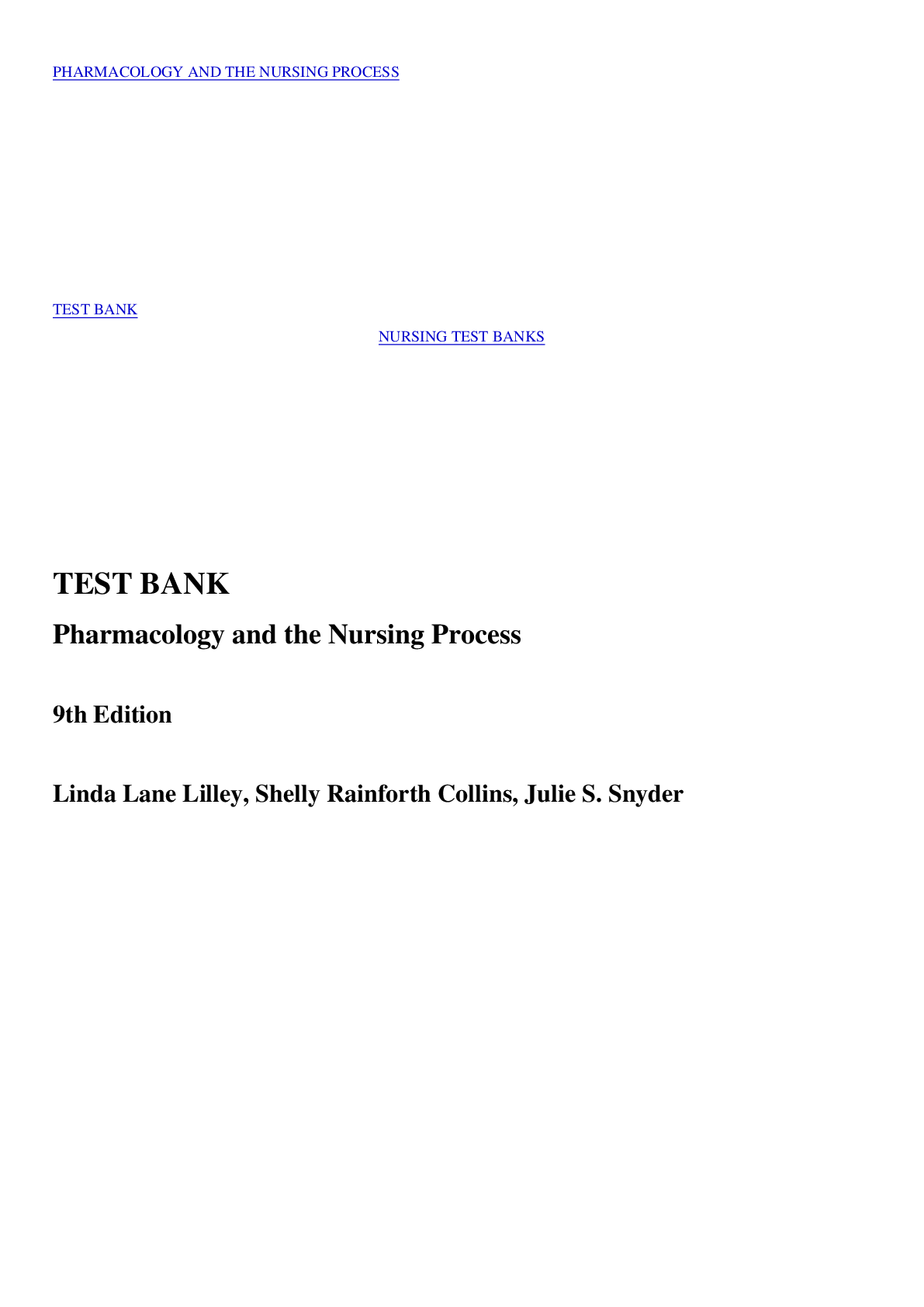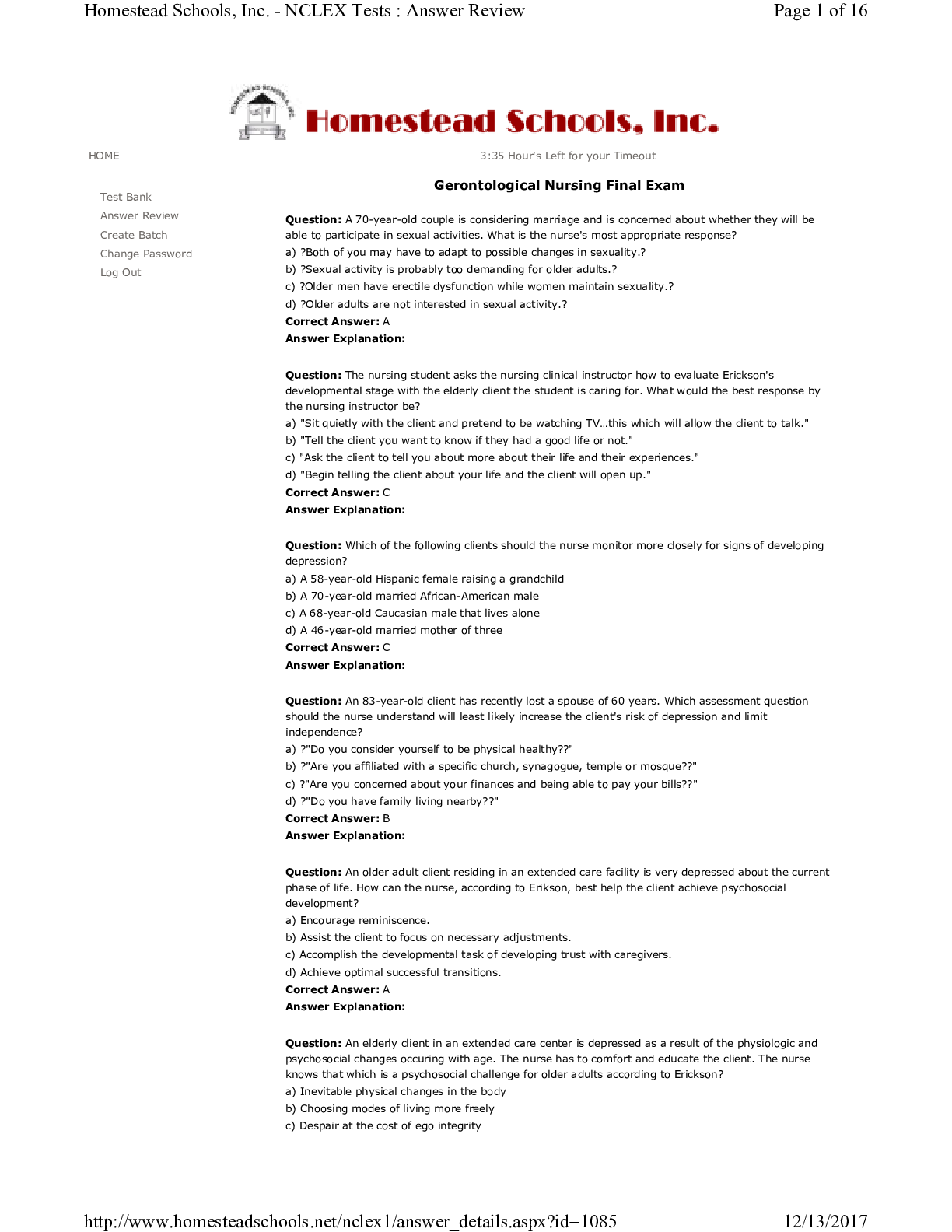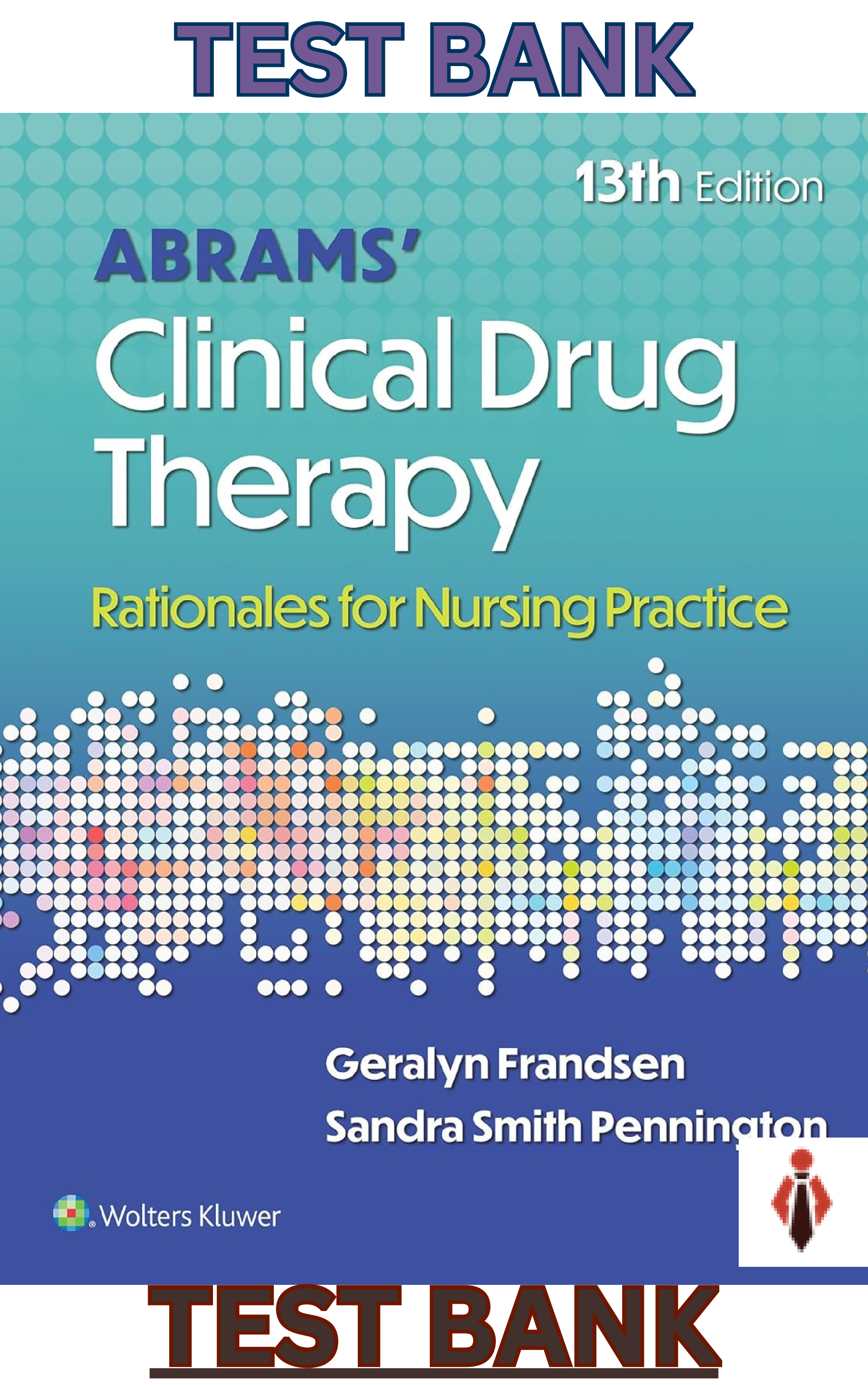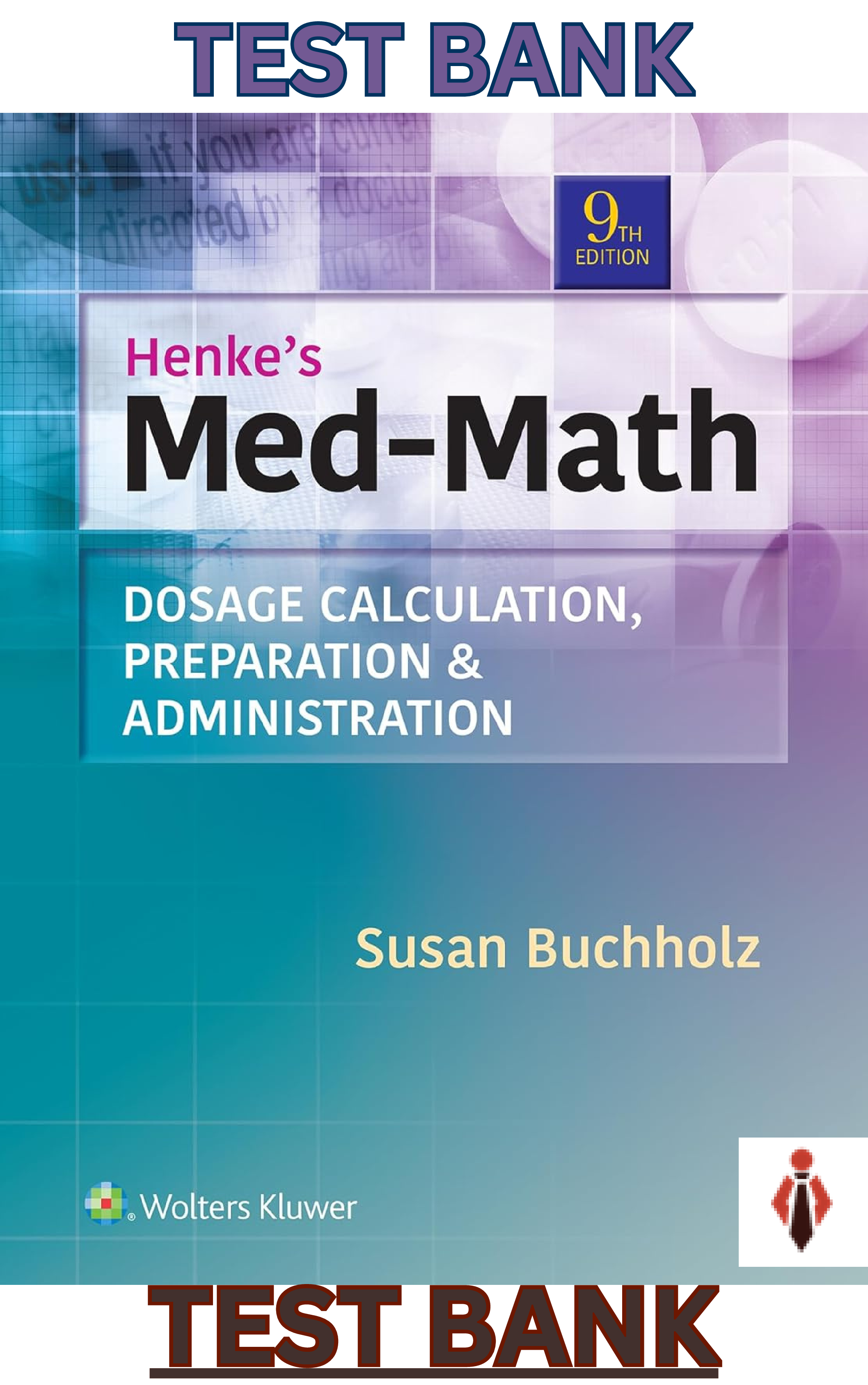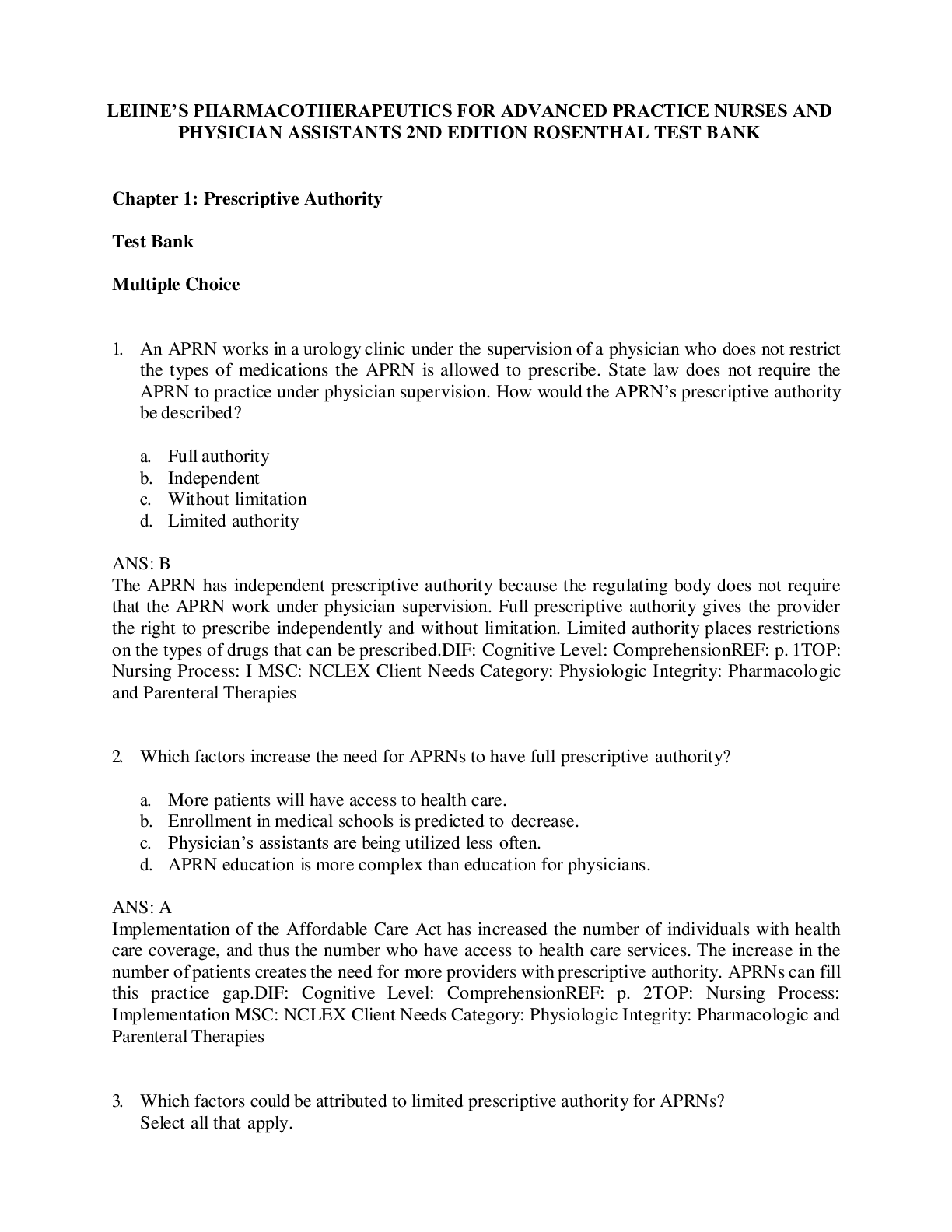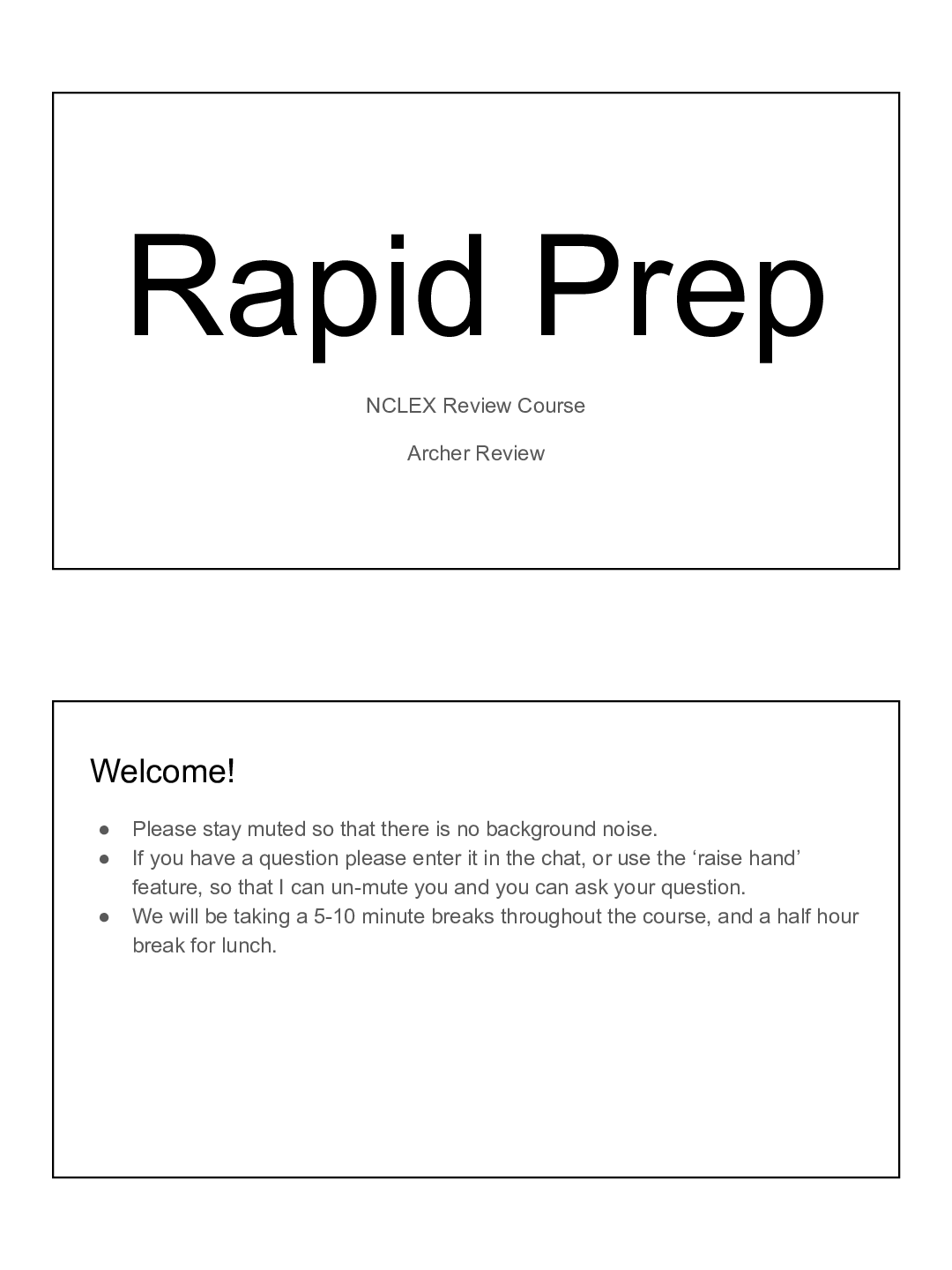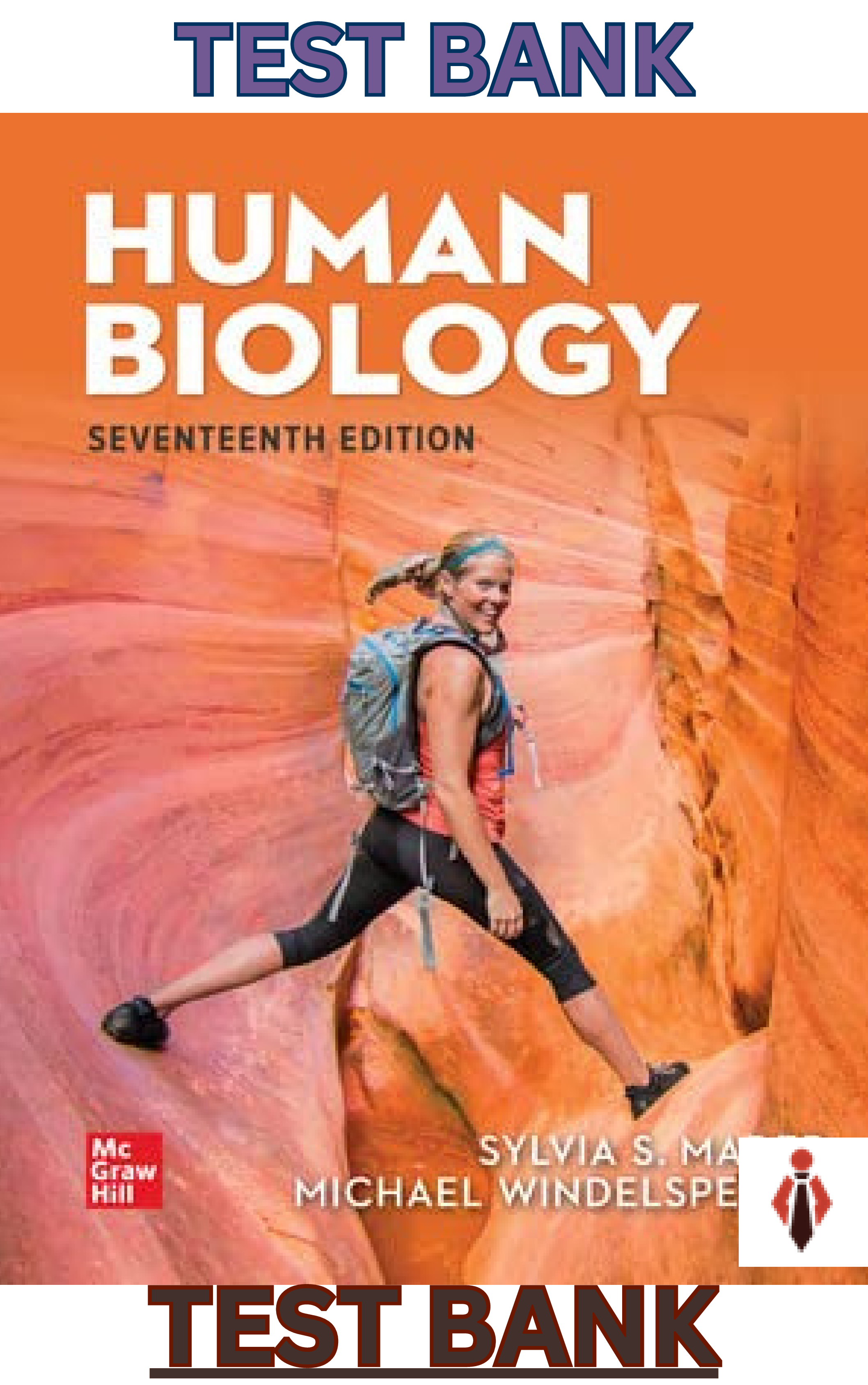Pharmacology > TEST BANK > Pharmacology Quizlet--FINAL EXAM.docx. QUESTIONS BANK WITH ACCURATE ANSWERS. GRADED A+ (All)
Pharmacology Quizlet--FINAL EXAM.docx. QUESTIONS BANK WITH ACCURATE ANSWERS. GRADED A+
Document Content and Description Below
Chapter 01: Drug Regulation, Actions, and Responses Workman & LaCharity: Understanding Pharmacology: Essentials for Medication Safety, 2nd Edition MULTIPLE CHOICE BASIC CONCEPTS 1. Which health c... are professional has the major responsibility for dispensing prescribed drugs under the direction of a pharmacist? a. Physician b . Nurse practitioner c. Licensed nurse d . Pharmacy technician ANS: D The physician and nurse practitioner have the major responsibility for prescribing drugs, not dispensing them. The licensed nurse has the primary responsibility for administering drugs, although under some circumstances a licensed nurse may dispense prescribed drugs but this is not his or her major responsibility in drug therapy. The pharmacy technician has the major responsibility of dispensing prescribed drugs under the direction of a licensed pharmacist. DIF: Cognitive Level: Remembering REF: p. 3 2. Which term describes the effect of a drug that improves body function? a. Side effect b . Intended action c. Adverse reaction d . Idiosyncratic response ANS: B The purpose of drug therapy is to take a drug to prevent, reduce, or correct a health problem. This response is any drug’s intended action also known as a therapeutic response. DIF: Cognitive Level: Remembering REF: p. 3 3. Which type of drug name is “owned” by the company that manufactures it? a. Generic name b Chemical name Pharmacology Final Study Guide . c. Category name d . Trade name ANS: D The chemical name is a drug’s exact chemical composition. The generic name is the name assigned to the drug by the U.S. Adopted Names Council and is not owned by anyone. The category name refers to the type of drug (what it does or what it is used for) and is not an actual drug name. The trade name (brand name) is the name provided and owned by a specific drug’s manufacturer. DIF: Cognitive Level: Remembering REF: p. 4 4. Which drug or drug class is a “high alert” drug? a. Penicillin b . Insulin c. NSAIDs d . Calcium ANS: B A high alert drug is one in which harm is likely to result if given at the wrong dose, to the wrong patient, or not given to the correct patient. Drugs classified as high alert drugs include potassium, narcotics (opioids), insulin, cancer chemotherapy drugs, and heparin (or any drug that strongly affects blood clotting). Penicillin, NSAIDs, and calcium are not considered high alert drugs. DIF: Cognitive Level: Remembering REF: p. 4 5. What is the term for a drug that has the same action as a naturally occurring body hormone or enzyme? a. Agonist b . Blocking agent c. Chemical d . Duplicator ANS: A A drug agonist is an extrinsic drug that activates the receptor sites of a cell and mimics the actions of naturally occurring body substances (intrinsic drugs). A blocking agent is a drug Pharmacology Final Study Guide antagonist. A chemical would not necessarily be a drug at all. A duplicator is not a pharmacologic term. DIF: Cognitive Level: Remembering REF: pp. 6-7 6. Which term describes how the body affects drug activity? a. Drug potency b . Pharmacodynamics c. Therapeutic effect d . Pharmacokinetics ANS: D The term pharmacokinetics refers to drug metabolism and how the body changes a drug. Pharmacodynamics refers to how a drug works to change body function. Drug potency refers to how strongly or to what degree a drug exerts its effects. The therapeutic effect is closer to pharmacodynamics, meaning how a drug works to change body function. DIF: Cognitive Level: Remembering REF: p. 10 7. In the United States, which group is responsible for enforcing established standards for drug manufacturing? a. U.S. Pharmacopeia b . National Institutes of Health c. Food and Drug Administration d . Association of Pharmaceutical Manufacturers ANS: C The standards for drug manufacture are established by the U.S. Pharmacopeia. These standards are enforced by the Food and Drug Administration. Neither the National Institutes of Health nor the Association of Pharmaceutical Manufacturers has any authority to enforce drug standards. DIF: Cognitive Level: Remembering REF: p. 5 8. Which factor is a major disadvantage of the transdermal drug delivery route? a. Only a prescriber can administer drugs by the transdermal route. b . Transdermal drugs must be sterile rather than clean. c. First pass drug loss by this route is the most extensive. d Drug absorption is dependent on adequate circulation. Pharmacology Final Study Guide . ANS: D Once a transdermal drug moves through the skin, it must enter the bloodstream to reach its target tissue. If circulation is poor to the area where the transdermal drug is applied, very little, if any, of the drug will reach its target tissue. DIF: Cognitive Level: Remembering REF: p. 12 9. How are intrinsic drugs different from extrinsic drugs? a. Intrinsic drugs are made by the body, whereas extrinsic drugs are made outside the body. b . Intrinsic drugs are administered by the parenteral route, whereas extrinsic drugs are administered by the oral route. c. Extrinsic drugs can only be applied to the skin or mucous membranes, whereas intrinsic drugs are taken internally. d . Extrinsic drugs require a prescription for administration, whereas intrinsic drugs are available over-the-counter. ANS: A Intrinsic drugs are the hormones, enzymes, and other chemicals made by the body that change cell activity. Extrinsic drugs are manufactured from chemical, animal, or plant sources and must have a means of entering the body in order to change cell activity. DIF: Cognitive Level: Understanding REF: p. 3 10. A patient asks why his drug to control high blood pressure has only one generic name and two different trade names. What is your best response? a. “Most drugs have different trade names that indicate different dosages.” b . “The two different trade names indicate that one is a more pure and safer drug than the other.” c. “The generic name is the actual official drug name and the trade name is a brand owned by a specific manufacturer.” d . “If you have insurance, you can get the trade name drug, which is usually more expensive than the generic named drug.” ANS: C The generic name is the name assigned to the drug by the U.S. Adopted Names Council and is not owned by anyone. The trade name (brand name) is the name provided and owned by a specific drug’s manufacturer. More than one manufacturer can make and sell the same drug at the same time under a different trade name. Regardless of trade name, all drugs that have the same generic name must be alike in their chemical composition and strength. DIF: Cognitive Level: Applying or Higher REF: pp. 3-4 Pharmacology Final Study Guide 11. How are the terms drug and medication different in the health care environment? a. Medications must be prescribed, whereas drugs are available over-the-counter. b . Medications are used to treat health problems, whereas drugs can be misused. c. Drugs are always illegal, whereas medications are legal. d . There is no difference between these two terms. ANS: D Although the lay public may think there is a distinction between these two terms, in health care they mean the same thing. Both are used to treat health problems and both can be misused. DIF: Cognitive Level: Understanding REF: p. 2 12. The prescriber tells a patient with allergies to use oral diphenhydramine (Benadryl) overthe-counter (OTC) to help manage her symptoms. She tells you that she would rather have a prescription for the “real” Benadryl because she knows it is stronger and will work better than the nonprescription form. What is your best response? a. “If you receive a prescription for this drug your name will be added to a controlled substances list.” b . “It is better to use the OTC Benadryl rather than the prescribed form because it has fewer side effects.” c. “The OTC form of Benadryl is the same strength as the one that was available by prescription only.” d . “You are correct. I will ask the health care provider to write a prescription so that you can get the most effective drug.” ANS: C Diphenhydramine (Benadryl) is no longer available by prescription only. The OTC form has the same strength, action, and side effects that the prescription only drug had. DIF: Cognitive Level: Applying or Higher REF: p. 4 13. Why is it important to always ask a patient about his or her use of any herbal supplements or botanicals? a. Many states do not have regulations about herbal supplements or botanicals. b . These substances are illegal and their use by patients must be reported. c. Patients who use botanicals seldom take their prescribed drugs. d . These substances can interact with a prescribed drug. Pharmacology Final Study Guide ANS: D Many herbal supplements and botanicals have effects on cell activity. Sometimes these agents can make drug side effects worse or can reduce the effectiveness of a prescribed drug. Others can actually cause health problems. DIF: Cognitive Level: Understanding (Comprehension) REF: p. 5 14. How are the effects of naturally occurring testosterone changed when a patient is taking a drug that is a testosterone agonist? a. Effects are increased. b . Effects are decreased. c. Effects are eliminated. d . Effects are unchanged. ANS: A An agonist drug has the same effects of the naturally occurring drug. So, taking a testosterone agonist adds to the effects of the patient’s naturally occurring testosterone. DIF: Cognitive Level: Understanding REF: pp. 6-7 15. Which feature of a drug agonist increases its potency? a. It is water soluble. b . It binds tighter and longer to its receptors than do other drugs. c. It is excreted through the intestinal tract rather than through the kidneys. d . It is administered intramuscularly rather than by the intravenous route. ANS: B A drug agonist binds to its receptors to cause a change in the cells and tissues. The longer a drug remains bound to its receptors and the more tightly it binds increases its duration of response, making it more potent than a drug that binds with its receptors for a shorter time. DIF: Cognitive Level: Understanding REF: p. 7 16. Which statement about agonist and antagonist drugs is true? a. The target tissues for these types of drugs are invading bacteria and viruses. b . Both agonist and antagonist drugs must interact with receptors to produce their intended responses. c. Antagonist drugs produce only intended responses and agonist drugs produce both intended responses and side effects. d These types of drugs are less likely to cause allergic responses than drugs that are neither Pharmacology Final Study Guide . agonists nor antagonists. ANS: B Agonist drugs excite a receptor to produce their intended responses on a cell or tissue in the same way that a naturally occurring substance does. Antagonist drugs produce their intended responses by binding to and blocking receptors. DIF: Cognitive Level: Understanding REF: pp. 6-7 17. A patient asks why he must take a “loading dose” for the first dose of his prescribed drug and then take lower doses after that. What is your best response? a. “The loading dose allows the first dose of this drug to get into your bloodstream faster and because it stays in the bloodstream a long time, you can take lower doses after that.” b . “The first dose of a drug has to be higher to reach the bloodstream because the liver destroys it before it has a chance to start its action and work for you.” c. “By taking the highest dose first and just once, you are reducing the likelihood of having a bad reaction or other side effects to this drug.” d . “This schedule helps by ensuring that the drug is having an effect even if you forget to take the rest of the doses.” ANS: A A loading dose is most often used with drugs that have a long half-life. Giving a higher dose for the first dose allows it to reach the bloodstream rapidly and stay there. Smaller doses follow it to keep the blood drug level at a steady state without increasing the risk for a drug over dose. DIF: Cognitive Level: Applying or Higher REF: p. 16 18. Which action could make a drug more potent? a. Slow drug absorption b . Slow drug elimination c. Normal drug elimination d . Fast drug elimination ANS: B Any condition that keeps a drug active inside the body longer can increase its potency. Slow drug elimination allows a drug to remain longer in the body. Normal or fast elimination does not. Slow drug absorption does not contribute to potency. DIF: Cognitive Level: Understanding REF: p. 15 Pharmacology Final Study Guide 19. When teaching a patient about adverse drug reactions (ADRs), which precaution is most important to include? a. “Take your medications right before you go to bed so that you can sleep through an ADR.” b . “Keep a written record of the date and time an ADR occurs.” c. “Stop taking the drug and flush it down the toilet.” d . “Immediately seek medical help.” ANS: D An adverse drug reaction can cause tissue damage and death. Any patient experiencing an ADR needs to seek medical help immediately to reduce the chances of serious problems. DIF: Cognitive Level: Applying or Higher REF: pp. 8-9 20. A patient tells you that she is allergic to the drug her health care provider just prescribed. What is your best first response or action? a. Ask her to describe the allergic response she had previously to this drug. b . Ask her whether she received the drug she was allergic to by mouth or by injection. c. Thank her for the information and ask the health care provider to prescribe something else. d . Tell her that the health care provider will also prescribe an antidote that will prevent an allergic response to the prescribed drug. ANS: A Many patients do not understand the difference between a side effect, an allergy, and an adverse effect. She may really have had an allergic reaction or perhaps just experienced a side effect that would not preclude her receiving this drug again. It is important to find out just what the reaction involved in order to determine whether she should receive this drug. DIF: Cognitive Level: Applying or Higher REF: p. 9 21. How would a drug dose that is below the minimum effective concentration (MEC) affect a patient’s response to the drug? a. Drug entry exceeds drug elimination. b . The intended response fails to occur. c. The risk for toxic side effects is increased. d . The drug’s duration of action is longer than expected. ANS: B Pharmacology Final Study Guide In order for a drug to produce its intended response, its blood levels must reach the MEC. Therefore, any drug dose that does not reach the MEC would be ineffective. DIF: Cognitive Level: Understanding REF: pp. 10-11 22. A patient asks why she becomes sleepy after she takes a specific drug but that her neighbor who takes the same drug at the same dose does not experience sleepiness. What is your best response? a. “Your neighbor may also be taking another drug to reduce the side effects of this drug.” b . “Your neighbor is probably addicted to this prescribed drug and you are not.” c. “Side effects are very dependent on the time of day when the drug is taken.” d . “People often experience side effects of the same drug differently.” ANS: D Although all drugs have at least one side effect, not every patient who takes the drug will have every side effect. DIF: Cognitive Level: Applying or Higher REF: p. 8 23. What precaution do you need to take when a patient is prescribed a drug that has a “black box warning?” a. Avoiding oral administration of this drug. b . Avoiding intravenous administration of this drug. c. Closely observing the patient for specific adverse reactions. d . Ensuring that the prescriber is present when the drug is given. ANS: C A black box warning indicates that a drug may produce specific serious or even life-threatening effects in some people in addition to the beneficial effects. It is important that the patient understand the potential problems and that you carefully observe the patient for any signs that such a reaction is happening. The drug route is not the reason a drug has a black box designation. It is not usually necessary for the prescriber to be the health care professional administering the drug. DIF: Cognitive Level: Applying or Higher REF: p. 9 24. Morphine and hydromorphone (Dilaudid) are two types of opioid receptor agonists used for pain management. Hydromorphone is a more potent drug than morphine, and lower doses are needed to control pain. How do actions at receptor sites explain this difference? a. Morphine remains bound to opioid receptors longer than hydromorphone does. Pharmacology Final Study Guide b . Hydromorphone remains bound to opioid receptors longer than morphine does. c. Morphine is metabolized and eliminated at a faster rate than hydromorphone. d . Hydromorphone is metabolized and eliminated at a faster rate than morphine. ANS: B The length of time and intensity of an agonist drug’s response is related to how tightly and how long it remains bound to its receptors. More potent agonist drugs stay bound longer than do weaker agonist drugs. DIF: Cognitive Level: Understanding REF: pp. 6-7 25. Which drug administration route is the least predictable? a. Enteral b . Intravenous c. Transdermal d . Subcutaneous ANS: A Many issues within an individual patient’s gastrointestinal system can affect drug absorption and, to some extent, drug metabolism. In addition, any food or beverages taken at the same time as an oral drug also affect drug absorption. DIF: Cognitive Level: Understanding REF: p. 13 26. Why is the intravenous route of drug administration route the most dangerous? a. If the needle clogs, the patient does not receive the drug. b . The intestinal tract does not detoxify these drugs. c. Drugs are immediately bioavailable. d . Drugs have extensive “first pass” loss. ANS: C Drugs administered intravenously are immediately available in the bloodstream. If the dosage is wrong or if it is the wrong drug, there is no simple way to stop the drug’s action. DIF: Cognitive Level: Understanding (Comprehension) REF: p. 13 Pharmacology Final Study Guide 27. The likelihood that a drug will sequester (be trapped) in fat cells and remain in the body longer is increased by which drug characteristic? a. Dissolves easily in water b . Dissolves easily in lipids c. Physical small size d . Physical large size ANS: B Drugs that are lipid soluble (dissolve easily in lipids) enter the plasma membranes of all cells more easily than water-soluble drugs. When a lipid-soluble drug enters a lipid environment (e.g., inside a fat cell), it is often sequestered there and takes a much longer time to be eliminated. DIF: Cognitive Level: Understanding (Comprehension) REF: p. 12 28. A patient has a deficiency of an enzyme that prepares a specific drug for elimination. For which response or issue should you remain alert? a. Toxic blood levels of the drug are more likely to occur. b . Higher drug dosages will be needed for the intended action to occur. c. The drug will be eliminated more rapidly in the feces rather than in the urine. d . Delivery of this drug by the parenteral route is more effective than by the enteral route. ANS: A When a patient has a deficiency of the enzyme needed for drug elimination, the drug remains in the body much longer. The risk for even “normal” dosages to cause serious side effects is higher, and toxic drug blood levels can occur quickly. If such a drug is prescribed for this patient, the dosage is lowered and the drug is administered less often. DIF: Cognitive Level: Applying or Higher REF: p. 15 29. A patient has all of the following health problems. Which problem increases his or her risk for drug side effects? a. Asthma b . Kidney disease c. GI ulcers d . Chronic high blood pressure ANS: B Pharmacology Final Study Guide The liver and kidneys are the organs that are most important for drug metabolism and elimination. A problem that decreases the function of either organ increases active blood drug levels and the length of time a single drug dose remains in the body. Both conditions lead to an increased risk for drug side effects. DIF: Cognitive Level: Applying or Higher REF: p. 15 30. When a patient takes 400 mg of an oral dru [Show More]
Last updated: 1 year ago
Preview 1 out of 418 pages
.png)
Reviews( 0 )
Document information
Connected school, study & course
About the document
Uploaded On
Mar 19, 2022
Number of pages
418
Written in
Additional information
This document has been written for:
Uploaded
Mar 19, 2022
Downloads
0
Views
163

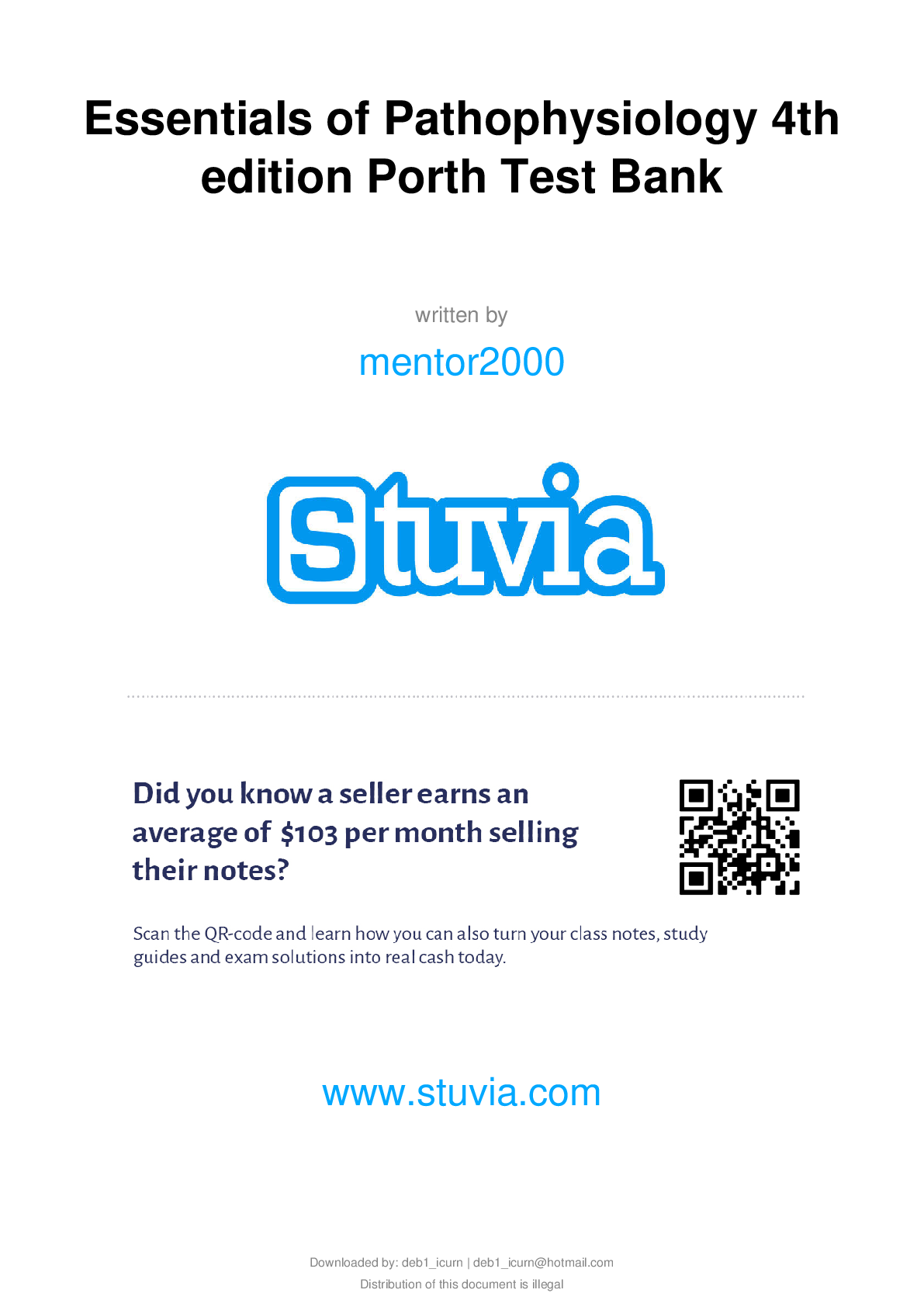

.png)
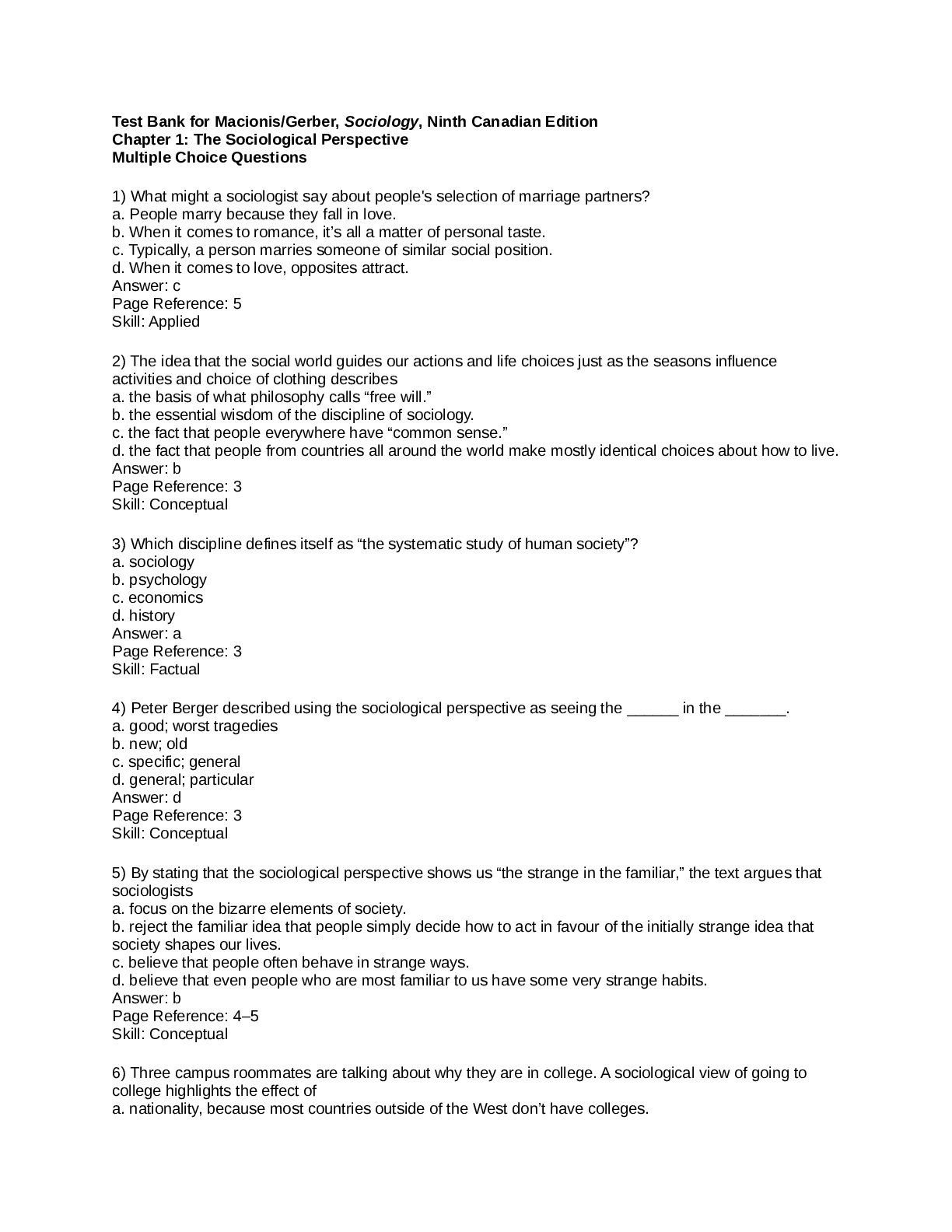
.png)
.png)
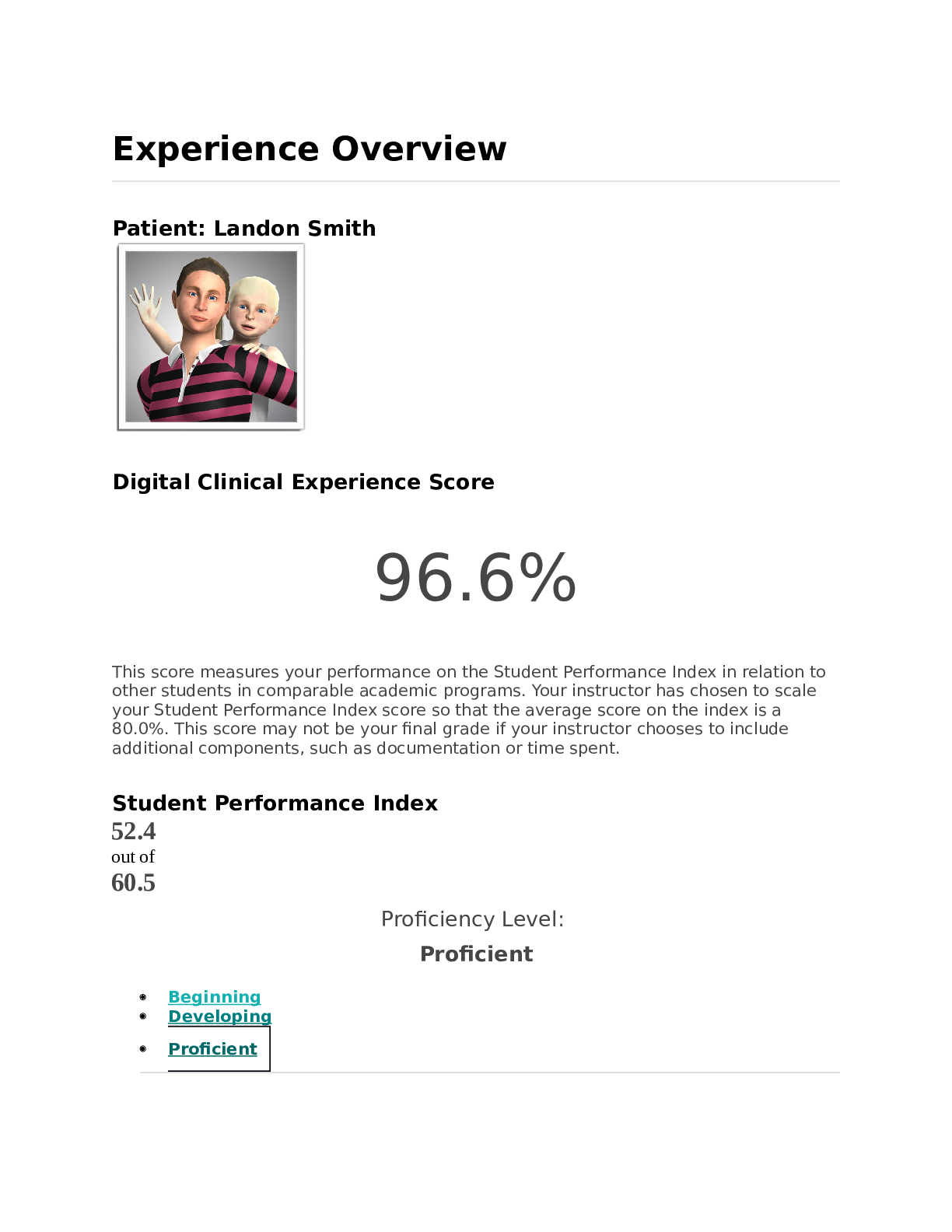
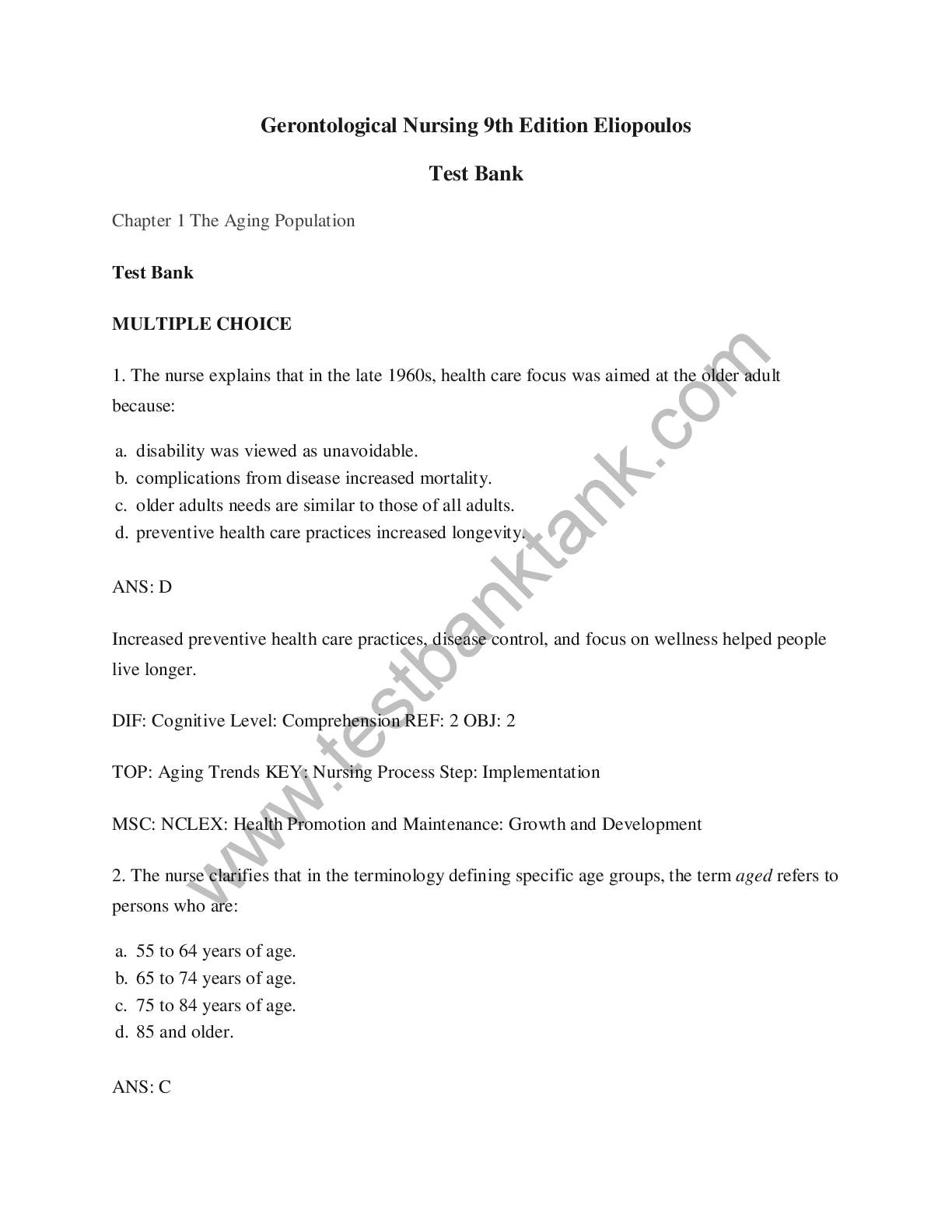

.png)
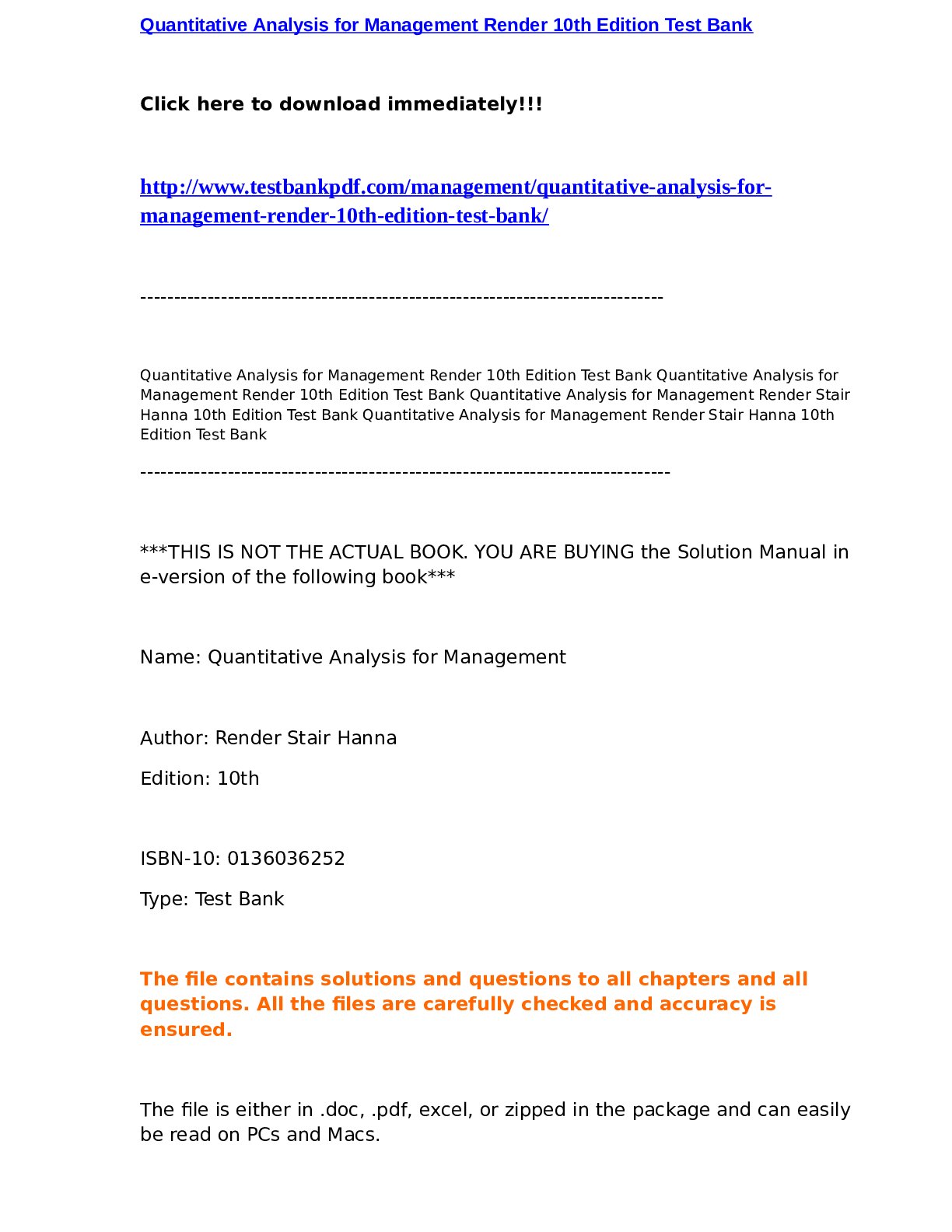
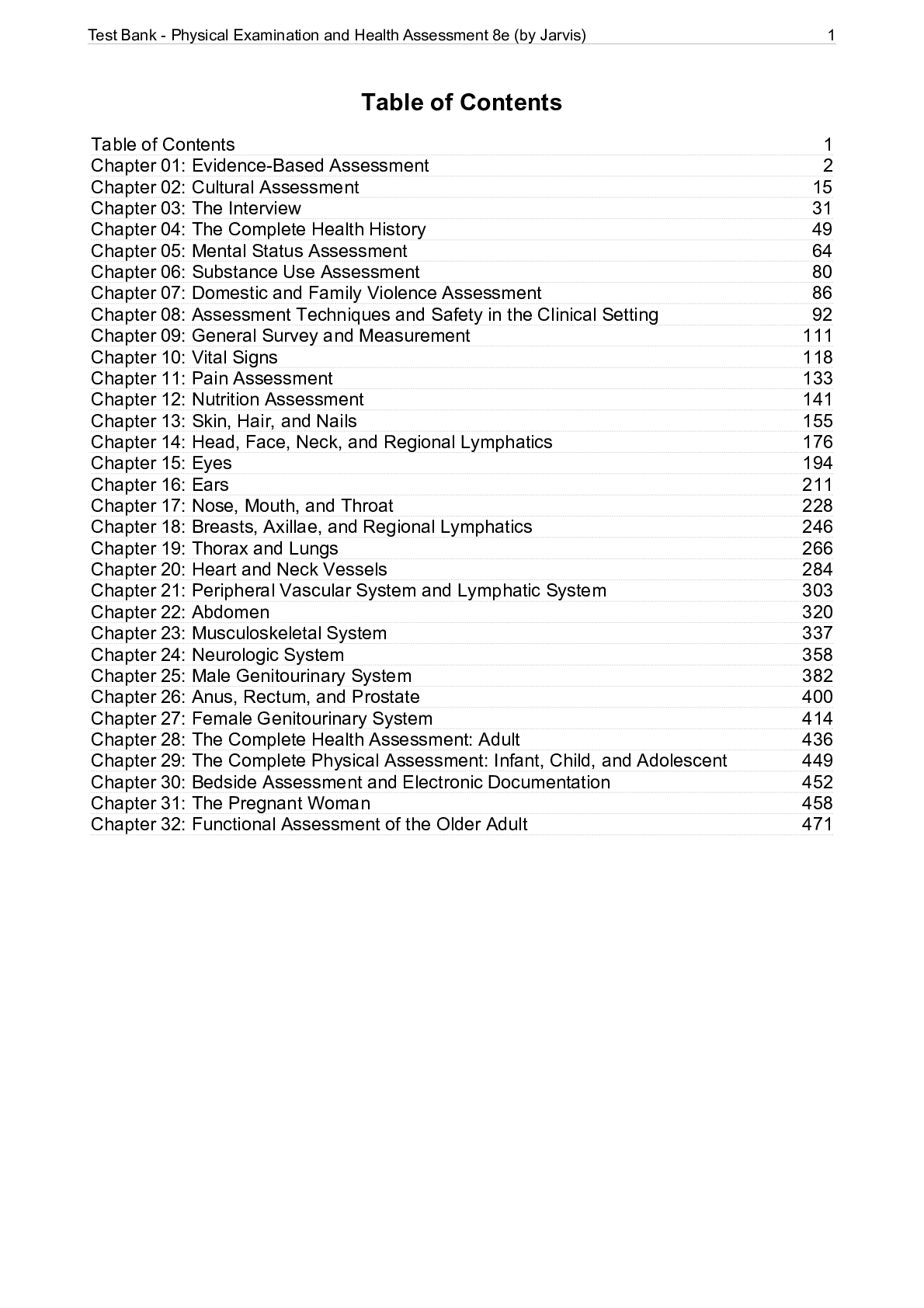

.png)
.png)


.png)
.png)
